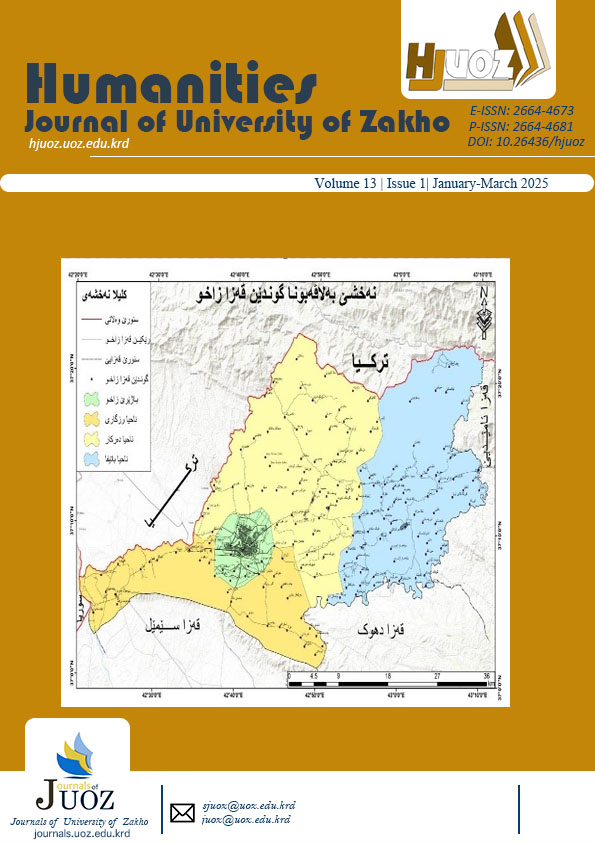شرۆڤەکرنا پێشنموونەیێن واتاسازی یێن خوارنێ د کوردیا بەهدینی دا
DOI:
https://doi.org/10.26436/hjuoz.2025.13.1.1537الكلمات المفتاحية:
تیۆرا پێشنموونەیی، واتاسازییا مەعریفیدا، کەتیگۆری، خوارن، کوردیا بەهدینیالملخص
تیۆرا پێشنموونەیی تیۆرەکا گرنگە د بیاڤێ کەتیگۆربەندیێدا د واتاسازیا مەعریفیدا، کۆ د ساڵێن (١٩٧٠) یان ژلایێ ڤەکۆلەر (رۆشێ ) ڤە هاتیە دەستنیشانکرن. ئەڤ تیۆرە چارچووڤەکێ بنگەهییە د واتاسازیا مەعریفیدا، بۆ تێگەهەشتنا پێکهات و ڕێکخستنا کەتیگۆریێن د مەژیێ مرۆڤی دا. ئارماج ژ ئەڤێ ڤەکۆلینێ ئەوە دیارکرنا پێشنموونەیێن واتاسازی یێن کەتیگۆریێن خوارنێ د کوردیا بەهدینی دا، بۆ هندێ وێ ڤالاهیا د ڤەکۆلینێن سەردەمیانە پڕ بکەت. ئەڤ ڤەکۆلینە ڕێزبەندیا واتاسازیێن خوارنێ دیار دکەت، هەروەسا باشترین نموونە د هەر کەتیگۆریێ دا و کارتێکرنا ڕەگەزی ل سەر تێگەهەشتنا وان. ئەڤ ڤەکۆلینە چەندین پێشنموونەیێن واتاسازیێ شرۆڤە دکەت، وەک خوارنا مالان، خوارنا سەرپێ، سپیاتی، فێقی، زەرزەوات... هتد. ئەڤ ڤەکۆلینە ل دویڤ هەردۆک ڕێبازێن (شیکاری، ڕێژەی) هاتیە ئەنجامدان، ب ڕێکا دابەشکرنا ڕاپرسییەکێ کۆ پێکدهات ژ نەهـ کەتیگۆریا ل سەر (١٠٠) کەسان، (٥٠ نێر و ٥٠ مێ) کۆ زمانێ وان یێ دەیکێ کوردیا بەهدینی بوویە، ل دویڤ مودیولا رۆش (١٩٧٣، ١٩٧٥). د ئەنجامێ ڤەکۆلینێ دا، نەهـ کەتیگۆریێن خوارنێ د کوردیا بەهدینی دا دیار بوون و د هەر کەتیگۆرییەکێ دا، باشترین نموونە هەبووینە، وەک: (برنج و ئیپراخ) بۆ خوارنا مالان، (پیتزا) بۆ خوارنا سەرپێ، (بەقلاوە) بۆ شریناهیان... هتد. هەروەسا ب هەبوونا جوداهیێ دناڤبەرا هەلبژارتنێن نێر و مێ دا.
التنزيلات
المراجع
Abdullah, A. & Salih, S (2017). The use of prototype theory in the Kurdish languages. Humanities Journal of University of Zakho (HJUOZ), 5(2), 258–271. https://doi.org/10.26436/2017.5.2.310
Coleman, L., & Kay, P. (1981). Prototype semantics: The English word lie. Language, 57(1), 26–44. https://doi.org/10.1353/lan.1981.0002
Croft, W. & Cruse, D. A. (2004). Cognitive Linguistics. Cambridge: Cambridge University Press. https://doi.org/10.1017/cbo9780511803864
Evans, V. & Green, M. (2006). Cognitive linguistics: An introduction. GB: Edinburgh University Press. http://www.gbv.de/dms/bs/toc/50769533x.pdf
Fauconnier, G. (1985). Mental spaces: Aspects of meaning construction in natural language. Cambridge, MA: MIT Press. https://psycnet.apa.org/record/1994-98635-000
Foroni, F., & Rumiati, R. I. (2017). Food perception and categorization: From food/no-food to different types of food. In Handbook of categorization in cognitive science (pp. 271-287). Elsevier. https://doi.org/10.1016/B978-0-08-101107-2.00012-9
Fromkin, V. & Rodman, R. (1988). An Introduction to Language. 3rd ed. USA: CBS College Publishing. https://books.google.iq/books/about/An_Introduction_to_Language.html?id=AkwFgEx3QBgC&redir_esc=y
Gärdenfors, P. (1999). Some tenets of cognitive semantics. In Pragmatics & beyond. New series (p. 19). https://doi.org/10.1075/pbns.55.03gar
Geeraerts, D. (2010). Theories of lexical semantics. https://doi.org/10.1093/acprof:oso/9780198700302.001.0001
Giannakopoulou, A. (2003). Prototype theory: An evaluation. ECLOGA Working Papers, 3. http://hdl.handle.net/10547/625850
Jackendoff, R. (1983). Semantics and cognition. Cambridge, MA: MIT Press. https://psycnet.apa.org/record/1985-98223-000
Jamalifar, G. (2014). The conceptualization of fruit/vegetable distinction in Farsi and American English: A contrastive pragmatic approach. Procedia-Social and Behavioral Sciences, 98, 764–769. https://doi.org/10.1016/j.sbspro.2014.03.479
Jumaniyozovna, B. N. (2023). Prototype theory in cognitive linguistics. In Integration Conference on Integration of Pragmalinguistics, Functional Translation Studies and Language Teaching Processes (pp. 72-74). https://www.conferenceseries.info/index.php/online/article/download/967/873
Khollam, P., & Mane, P. (2019). Review on food categorization techniques in machine learning. Int. J. Res. Anal. Rev, 6, 107-111. http://ijrar.com/upload_issue/ijrar_issue_20543700.pdf
LaBar, K. S., Gitelman, D. R., Parrish, T. B., Kim, Y. H., Nobre, A. C., & Mesulam, M. M. (2001). Hunger selectively modulates corticolimbic activation to food stimuli in humans. Behavioral Neuroscience, 115(2), 493–500. https://doi.org/10.1037/0735-7044.115.2.493
Lakoff, G. (1987). Women, fire, and dangerous things: What categories reveal about the mind. Chicago/London: The University of Chicago Press. http://books.google.ie/books?id=9GxmrgEACAAJ&dq=Women,+fire,+and+dangerous+things:+What+categories+reveal+about+the+mind&hl=&cd=3&source=gbs_api
Langacker, R. (1987). Foundations of cognitive grammar: Volume I: Theoretical prerequisites. Stanford, CA: Stanford University Press. https://books.google.iq/books/about/Foundations_of_Cognitive_Grammar.html?id=g4NCRFbZkZYC&redir_esc=y
Lyons, J. (1981). Language and linguistics. GB: Cambridge University Press. https://doi.org/10.1017/cbo9780511809859
Palmer, R. F. (1981). Semantics (2nd ed). Cambridge: Cambridge University Press. https://books.google.iq/books/about/Semantics.html?id=UWJSaxH9GiMC&redir_esc=y
Parker, F. (1986). Linguistics for non-linguists. London: Taylor & Francis. https://books.google.iq/books/about/Linguistics_for_Non_linguists.html?id=s7lrAAAAIAAJ&redir_esc=y
Radden, G., & Dirven, R. (2007). Cognitive English grammar. In Cognitive linguistics in practice CLiP. USA: John Benjamins Publishing Company. https://doi.org/10.1075/clip.2
Rosch, E. (1973). On the internal structure of perceptual and semantic categories. Cognitive Development and the Acquisition of Language/New York: Academic Press, (pp. 111–144). https://doi.org/10.1016/B978-0-12-505850-6.50010-4
Rosch, E. (1975). Cognitive representations of semantic categories. Journal of Experimental Psychology General, 104(3), 192–233. https://doi.org/10.1037/0096-3445.104.3.192
Rosch, E., & Lloyd, B. B. (1978). Cognition and categorization. Lawrence Erlbaum Associates. https://www.cs.rice.edu/~vo9/recognition/2016/slides/lecture07/CognitionAndCategorization.pdf
Rosch, E., Mervis, C. B., Gray, W. D., Johnson, D. M., & Boyes-Braem, P. (1976). Basic objects in natural categories. Cognitive Psychology, 8(3), 382–439. https://doi.org/10.1016/0010-0285(76)90013-x
Schwanenflugel, P. J., & Rey, M. (1986). The relationship between category typicality and concept familiarity: Evidence from Spanish- and English-speaking monolinguals. Memory & Cognition, 14(2), 150–163. https://doi.org/10.3758/bf03198375
Sweetser, E. (1990). From etymology to pragmatics. Cambridge: Cambridge University Press. https://doi.org/10.1017/cbo9780511620904
Talmy, L. (1988). Force dynamics in language and cognition. Cognitive Science, 12(1), 49–100. https://doi.org/10.1207/s15516709cog1201_2
Talmy, L. (2000). Toward a cognitive semantics, volume 2: Typology and process in concept structuring. In The MIT Press eBooks. https://doi.org/10.7551/mitpress/6848.001.0001
United States Department of Agriculture. (2017). Back to basics: All about myplate food groups. https://www.usda.gov/media/blog/2017/09/26/back-basics-all-about-myplate-food-groups
University of Nebraska-Lincoln. (2022). What are the five food groups? https://food.unl.edu/article/food-groups
Yule, G. (2006). The study of language. 3rd ed. Cambridge: Cambridge University Press. https://books.google.iq/books/about/The_Study_of_Language.html?id=Zw5Y0o0q1bYC&redir_esc=y
Yule, G. (2014). The study of language. Cambridge University Press. https://books.google.iq/books/about/The_Study_of_Language.html?id=x-WfAgAAQBAJ&redir_esc=y
التنزيلات
منشور
كيفية الاقتباس
إصدار
القسم
الرخصة
الحقوق الفكرية (c) 2025 Edwardo Kh. Dinkha, Fakhir O. Mohammed

هذا العمل مرخص بموجب Creative Commons Attribution-NonCommercial-ShareAlike 4.0 International License.
يوافق المؤلفين الذين ينشرون في هذه المجلة على المصطلحات التالية
[CC BY-NC-SA 4.0] يحتفظ المؤلفون بحقوق الطبع والنشر ومنح حق المجلة في النشر الأول مع العمل المرخص له بموجب ترخيص مشاع المبدع للإسناد
الذي يسمح للآخرين بمشاركة العمل مع الإقرار بحقوق التأليف والنشر الأولي في هذا مجلة
مكن للمؤلفين الدخول في ترتيبات إضافية منفصلة للتوزيع غير الحصري للنسخة المنشورة من المجلة، مع الإقرار بإصدارها الأولي في هذه المجلة
يسمح ويشجع المؤلفين على نشر عملهم عبر الإنترنت

















